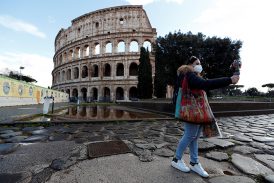By Elise Ann Allen
ROME (Crux) – When Pope Francis’ eco-encyclical was published in 2015, one aspect of the document that didn’t make waves but was key to implementing his overall vision for environmental reform was his appeal to cleanup cities, making them more organized and sustainable.
Now, six years later, this is being implemented in his own backyard.

According to a May 2 press release from the Italian Cultural Ministry, one of Rome’s most iconic monuments, the Colosseum, is getting a new floor that is both functional and environmentally conscious.
Italy and the Vatican have always maintained a unique balance of laïcité. Although this project is not necessarily a direct result of his encyclical, the pontiff’s voice carries significant heft in Italy, where most of the population is Catholic.
Plans to renovate the Colosseum’s floor were initially hatched in 2014, a year before the pontiff’s encyclical on environmental care, “Laudato Si,” was released. From 2015-2020, proposals were developed and pitched, with the final selection happening earlier this year.
Milan Ingegneria, a Venetian company, won the contract, which will cost around 18.5 million euros and is expected to be completed in 2023.
The new Colosseum floor will be done with movable carbon panels made of Accoya wood, which according to the ministry was obtained through a special process “that increases its strength and durability,” making it “a sustainable choice which avoids the killing of valuable species.”
Some of the panels will rotate, allowing natural light to flow into the basement structures. Distributed around the perimeter of the monument with be 24 mechanical ventilation units that will control humidity and temperature in the underground rooms.
“In just 30 minutes the complete exchange of the entire volume of air will be guaranteed,” the ministry said.
A collection system will also be installed allowing rainwater to feed the public bathrooms, making it a more environmentally conscious process.
Dario Franceschini, the Italian Culture Minister, called it an “ambitious project that will help the conservation and protection of the archeological structures by recovering the original image of the Colosseum and restoring its nature as a complex scenic machine.”
The “extraordinary” design will allow visitors to see the Colosseum as it used to be, up until the 19th century, Franceschini said, explaining that it will also be used as a stage for cultural events.
Rome’s Colosseum is going to look a little different after this new environmentally conscious addition makes it way to the iconic monument. pic.twitter.com/uddlsgJzoP
— Currents News (@CurrentsNews) May 4, 2021
Prior to the coronavirus pandemic, the Colosseum averaged roughly 20 thousand visitors a day, amounting to more than 7 million every year.
It is also the site where, prior to COVID-19, Pope Francis holds his annual Good Friday Via Crucis during Holy Week, which is usually attended by thousands of locals and pilgrims who come to pray alongside the leader of the world’s 13 billion Catholics.
For the past two years this service has been held privately in St. Peter’s Square to avoid crowds in keeping with restrictions in place to prevent the spread of COVID-19.
In addition to this, the Colosseum is also on occasion used to draw attention to other issues, such as anti-Christian persecution.
On several occasions, international Catholic charity Aid to the Church in Need (ACN) has held events in front of the monument, where numerous early Christian martyrs were killed, to draw attention to the plight of modern-day martyrs by symbolically casting a red light on in honor of all those who have been killed for their faith.
Whether and how this the Holy Father’s Via Crucis, or other events such as those organized by ACN, will be impacted by the new floor is yet to be seen, but if there is a way to do that is more environment-friendly, Francis is sure to embrace it.
Aside from “Laudato Si,” the pontiff has made frequent and vocal appeals to individuals and to the international community to adopt a more sustainable lifestyle, and to develop systems and structures which protect both the environment, and the poor.
He vocally supported initiatives such as the COP21 United Nations Climate Change Conference in Paris in 2015, and the upcoming COP26 climate conference on biodiversity set to take place in Glasgow in November, which it is rumored he might attend.
Pope Francis has also backed grassroot initiatives such as the student-led climate protests led by Swedish teen Greta Thunberg, a global icon for the fight against climate change who met Pope Francis during one of his general audiences in April 2019.
Even though the Colosseum’s new floor might not have been inspired by the pontiff himself, it is certainly in step with his agenda, and while the Vatican and Italian authorities are not in lockstep on every issue, this is at least one area where they can agree.
